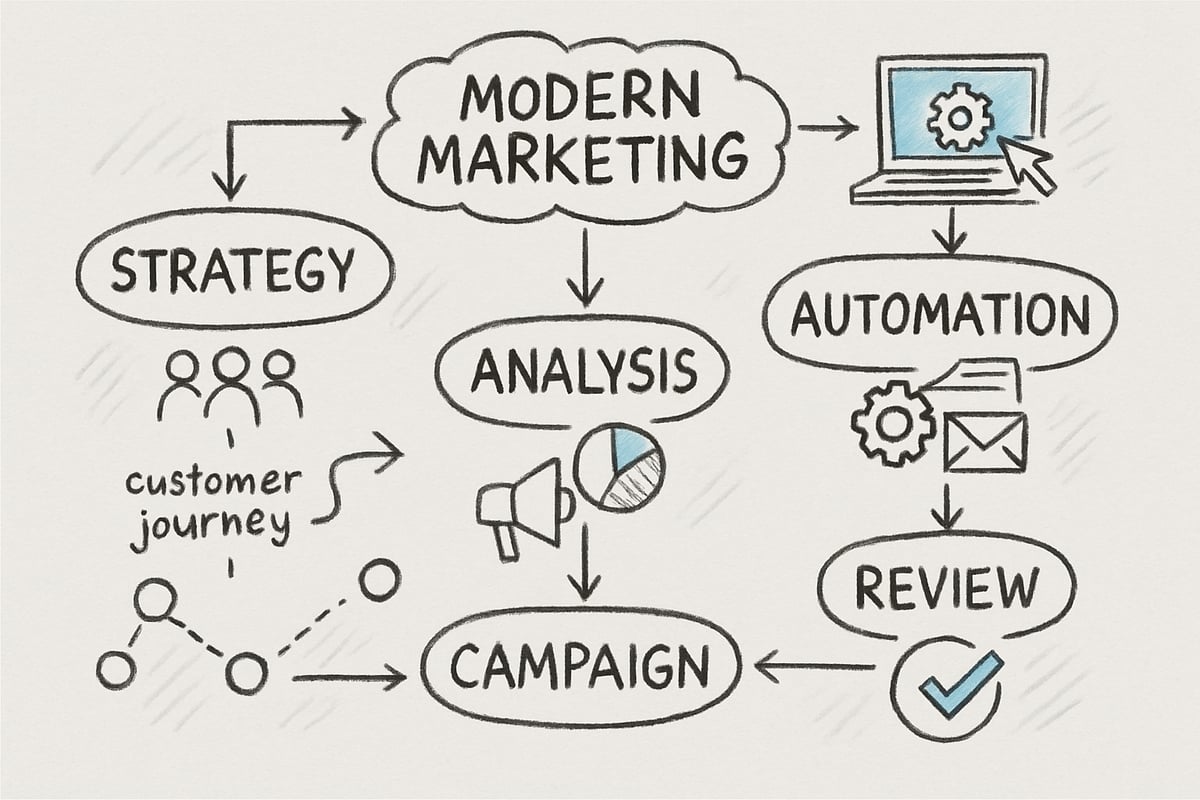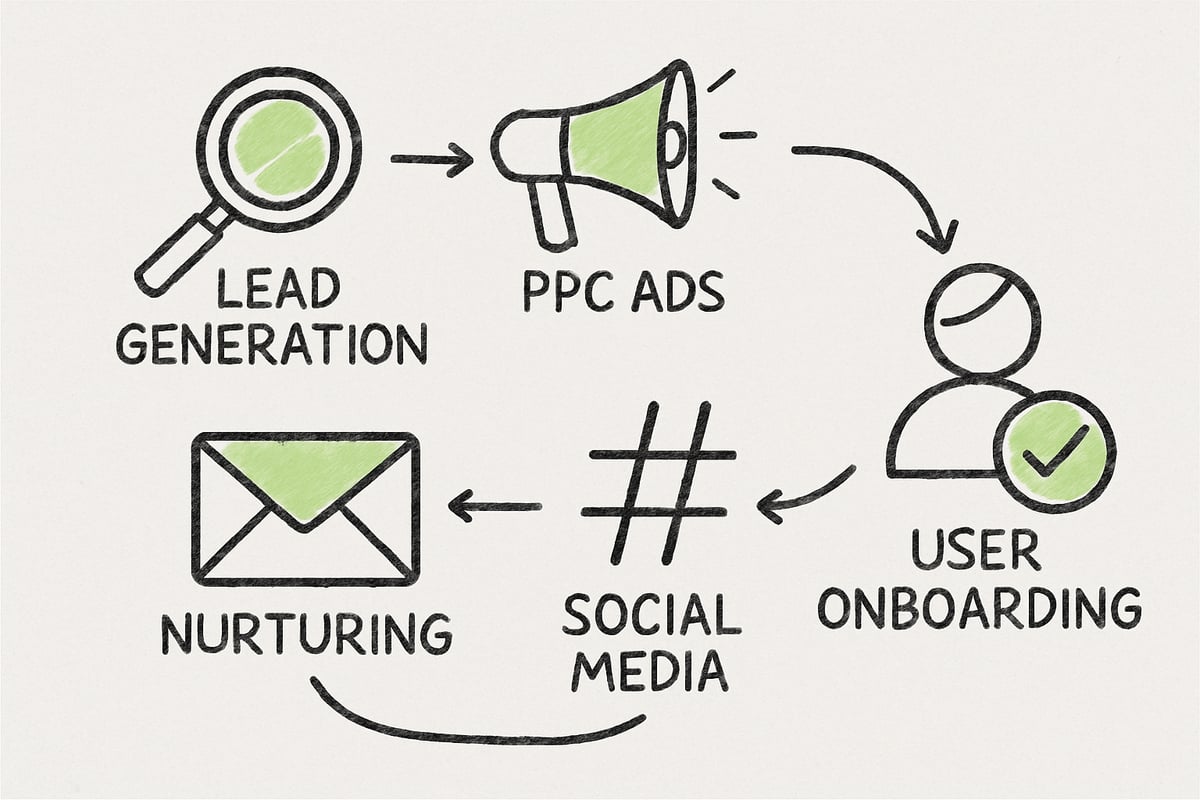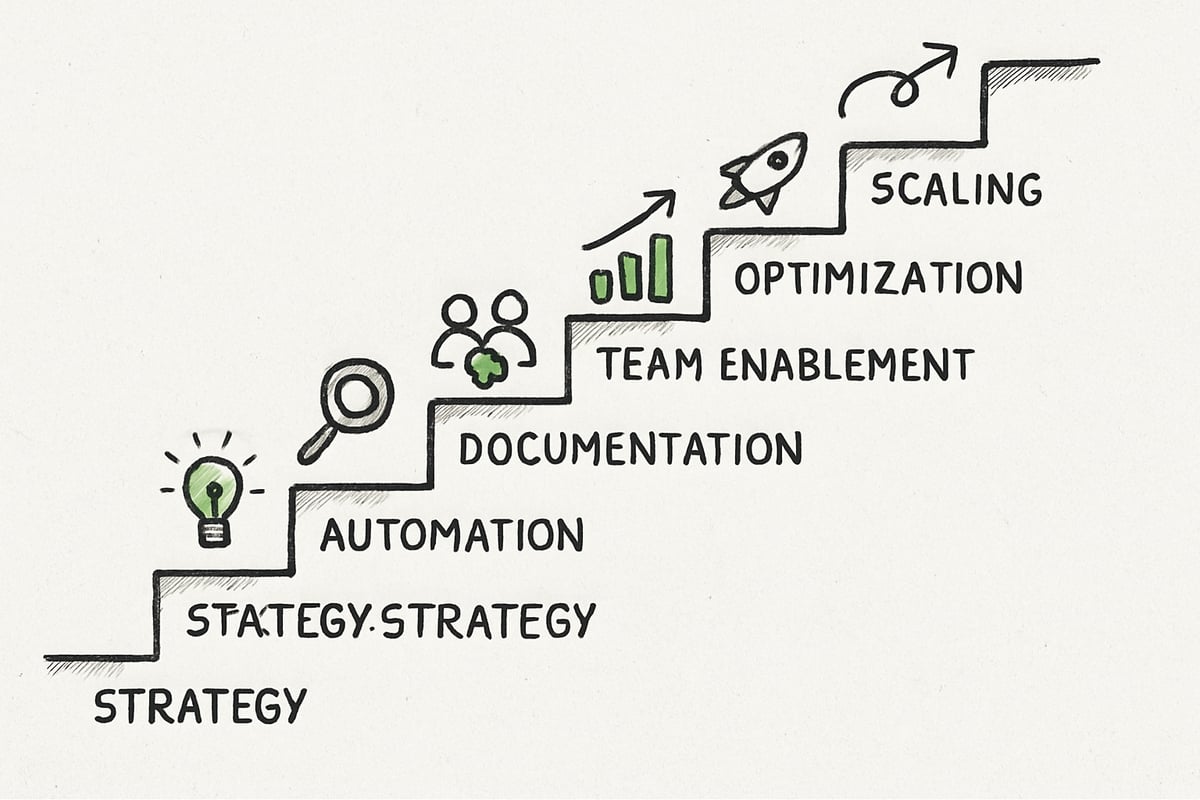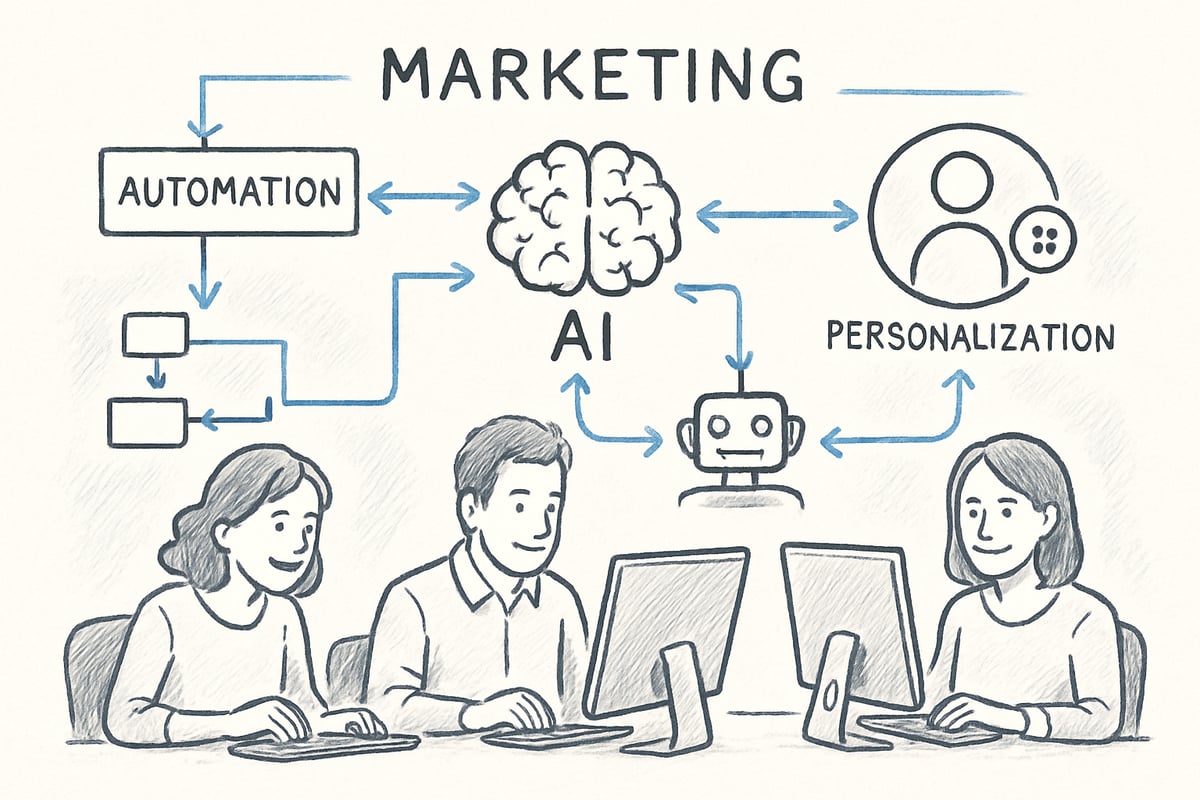In 2025, marketing success will be defined by those who master not just strategy, but the underlying processes that drive consistent results. The rapid evolution of digital channels, tools, and consumer expectations means businesses need more than good ideas—they need robust marketing processes.
This guide provides a comprehensive roadmap to help you master marketing processes for the new era. As marketing grows more complex, streamlined processes solve challenges such as inconsistent leads, unpredictable sales, and fragmented customer experiences.
With the right approach, you will boost productivity, create seamless customer journeys, and achieve measurable ROI. Ready to future-proof your marketing operations?
Explore how to define, implement, and optimize marketing processes, integrate automation and AI, and learn from real-world examples to build a scalable, future-ready marketing engine.
Understanding Modern Marketing Processes
Modern marketing processes are the backbone of successful campaigns in 2025. As digital channels multiply and customer expectations rise, having structured yet adaptable processes becomes essential. Let us explore what defines these processes, why they matter more than ever, their core elements, and common pitfalls to avoid.

Defining Marketing Processes in 2025
A marketing process is a repeatable set of steps designed to identify customer needs, analyze opportunities, and execute campaigns efficiently. In 2025, these processes must bridge internal productivity (team workflows) with external outcomes (customer journey). Agility and adaptability are now critical, as rapid market shifts demand quick adjustments.
Think of marketing processes like a recipe. Without a clear process, essential ingredients may be missed, leading to inconsistent results. Strategic marketing involves setting clear objectives, conducting research, testing, and adapting, as highlighted by AgileSherpas. Effective processes ensure that leadership strategy connects with real-world execution, creating a reliable foundation for growth.
Why Marketing Processes Matter More Than Ever
The impact of marketing processes extends far beyond efficiency. Well-defined processes drive consistency, scalability, and a strong return on investment. With more than 4.48 billion people active on social media (Backlinko), the complexity of tools and channels keeps increasing. Processes reduce wasted spend, improve customer experiences, and enable faster adaptation to new trends.
Marketing processes also align sales and marketing teams, closing gaps that can result in lost leads. For example, businesses using structured processes have achieved a 77 percent reduction in customer acquisition costs (Encharge/Samdock). In today's landscape, a process-driven approach is vital to stay competitive and meet evolving consumer expectations.
Key Elements of Effective Marketing Processes
The most effective marketing processes share several key components:
- Clear goal alignment with organizational objectives
- Thorough documentation for repeatability
- Automation to handle repetitive tasks and save time
- Measurement systems for ongoing performance tracking
- Regular review cycles for continuous improvement
Segmentation, personalization, and progressive profiling are essential for targeting the right audiences. Integrating feedback loops helps teams refine processes as new data emerges. Flexibility is crucial, allowing quick adjustments to market changes. To optimize these elements, many marketers are turning to automation strategies for marketers to streamline workflows and enhance results.
For instance, using lead scoring and segmentation allows teams to qualify leads efficiently, ensuring resources are focused where they matter most.
Common Pitfalls and How to Avoid Them
Despite their benefits, marketing processes can fall short if not managed carefully. Common pitfalls include overcomplication, lack of documentation, siloed teams, and inflexible plans. Relying solely on top-down directives can disconnect leadership vision from team realities, as AgileSherpas notes.
To avoid these issues, schedule regular process reviews, establish clear ownership, and encourage cross-functional collaboration. Companies that jump from tactic to tactic without a process often experience inconsistent results. Data shows that only 42 percent of marketers believe their processes are agile enough for today's pace (AgileSherpas SOAM 25 Report). Prioritizing adaptability and open communication helps keep marketing processes effective and future-ready.
Essential Marketing Processes to Build in 2025
Modern marketing processes are the backbone of high-performing teams in 2025. As digital channels multiply and consumer expectations rise, having well-defined processes is no longer optional. Instead, businesses that build, refine, and automate their marketing processes gain a measurable edge in consistency, scalability, and ROI.

Lead Generation Process
A strong lead generation process is foundational for effective marketing processes. Start by developing detailed buyer personas to understand your target audience. Use a balanced mix of inbound tactics like valuable content and SEO, and outbound tactics such as targeted outreach.
Qualify leads using behavioral data and lead scoring, ensuring only the most promising prospects move forward. For example, Landbot automated onboarding for over 80,000 users, saving 320 hours per month. This demonstrates how integrating AI tools for marketing processes can dramatically increase efficiency and conversion rates.
Effective lead generation processes double trial conversion rates. Blend both underutilized and proven methods for the best results.
Search Engine Marketing (SEM) & PPC Process
Search engine marketing processes are essential for visibility and growth in 2025. Begin with comprehensive keyword research, focusing on relevance to your audience. Next, create compelling ad copy and optimize bids for maximum impact.
Landing page quality is critical, as it directly affects quality score and ad rank. For example, using optimized headlines and targeted landing pages can significantly boost conversions. Remember, quality score impacts both your ad placement and cost per click.
SEM marketing processes should be tightly integrated with analytics, allowing ongoing campaign optimization and precise budget allocation.
Lead Nurturing Process
Nurturing leads is a vital component of successful marketing processes. Design workflows that send targeted, personalized messages based on user behavior and segmentation. Segment leads by industry, job title, and sales stage to deliver relevant content at every step.
Incorporate lead scoring and progressive profiling to collect data incrementally. Automated follow-ups for unresponsive leads can increase engagement and guide prospects down the funnel. Nurturing is not limited to emails—consider webinars, online courses, and downloadable assets.
Robust lead nurturing marketing processes ensure prospects remain engaged until they are sales-ready.
Social Media Marketing Process
A structured social media marketing process is crucial as social platforms remain primary touchpoints for billions. Start with audience research and select the platforms where your customers are most active. Define clear KPIs before developing a content calendar.
Consistent, helpful content builds brand community and trust. For example, brands that post daily and engage with followers see stronger loyalty and increased website traffic. Social media marketing processes also ensure messaging remains unified across platforms.
With 4.48 billion users globally, process-driven strategies maximize your brand’s reach and impact.
Customer Journey Mapping & User Onboarding
Mapping the customer journey is a core part of modern marketing processes. Identify all touchpoints from first contact to conversion and beyond. Use behavioral data to personalize onboarding sequences, ensuring new users quickly see value.
For instance, personalized onboarding boosts activation and reduces churn. Seamless onboarding relies on automated processes that adapt based on customer feedback and actions. This flexibility improves retention and overall satisfaction.
Effective customer journey mapping marketing processes must evolve with user needs and market trends.
Step-by-Step Framework to Master Marketing Processes
Mastering marketing processes requires a structured, iterative approach. The following eight-step framework guides you from strategy through execution, optimization, and agile adaptation. Each step is designed to ensure your marketing processes are robust, scalable, and ready for 2025.

Step 1: Strategic Planning & Goal Setting
Effective marketing processes start with clear alignment between organizational objectives and marketing goals. Begin by involving both leadership and frontline teams to ensure every voice is heard. Set measurable KPIs for each process to track progress and drive accountability.
Use a quarterly planning cycle to keep your strategy agile and responsive. For example, schedule regular reviews to adjust priorities based on evolving business needs. When marketing processes are grounded in strategy, your team can focus on what matters most and measure real impact.
Step 2: In-Depth Market & Competitor Analysis
A solid understanding of your market and competitors underpins all marketing processes. Conduct thorough research to validate your goals and identify gaps in the landscape. Benchmark your performance against competitors to spot opportunities and threats.
Adjust your marketing processes based on data-driven insights. For instance, if research shows a shift in customer preferences, pivot your messaging promptly. Ongoing analysis ensures your marketing processes stay relevant and competitive in a dynamic environment.
Step 3: Process Development & Documentation
Documenting marketing processes is essential for consistency and scalability. Start by mapping each workflow, outlining every step from planning to execution. Use visual tools like flowcharts or digital boards to make processes easy to understand and follow.
Involve cross-functional teams to capture diverse perspectives and gain buy-in. Create standard operating procedures (SOPs) for repeatable tasks. Well-documented marketing processes help new team members onboard quickly and reduce errors in campaign delivery.
Step 4: Technology Integration & Automation
Modern marketing processes rely on seamless technology integration. Identify tools for automation, such as email platforms, CRMs, and analytics suites. Connect your systems for smooth data flow, enabling real-time insights and rapid decision-making.
Automate repetitive tasks to free up your team's creative energy. For best results, explore resources like the Marketing and AI integration guide to learn how artificial intelligence can enhance your marketing processes. Proper integration and automation help you scale efficiently and maintain a competitive edge.
Step 5: Execution & Team Enablement
Empowering your team is critical to executing marketing processes effectively. Provide comprehensive training on new tools and workflows. Assign clear roles and responsibilities so everyone understands their contribution to each process step.
Foster a culture of accountability and continuous learning. Agile teams that are encouraged to adapt tactics mid-campaign are better equipped to respond to market shifts. When team members are confident in their roles, marketing processes run smoothly and produce better outcomes.
Step 6: Measurement, Review & Optimization
Measurement is at the heart of high-performing marketing processes. Set up dashboards to track KPIs and monitor performance in real time. Schedule regular process reviews and retrospectives to identify what’s working and what needs improvement.
Use feedback loops to iterate and refine your workflows. For example, analyze campaign data quarterly and make evidence-based adjustments. This commitment to measurement keeps your marketing processes adaptable and focused on continuous improvement.
Step 7: Scaling & Continuous Improvement
Once your marketing processes are optimized, look for opportunities to scale. Identify bottlenecks that limit growth and standardize successful workflows across teams and regions. Encourage experimentation with new channels and technologies.
Document best practices and share them internally to raise the bar for everyone. Scalable marketing processes support business growth and ensure your organization can handle increased demand without sacrificing quality.
Step 8: Embedding Agility into Processes
Agility is the final ingredient for future-ready marketing processes. Build in flexibility so your team can adjust to market changes quickly. Use short cycles or sprints for rapid testing and learning, balancing structure with responsiveness.
Adapt campaigns in real time based on performance data. Encourage open communication and empower teams to make informed decisions. Embedding agility in your marketing processes ensures you can pivot when needed and stay ahead in a fast-moving landscape.
Integrating Automation, AI, and Personalization in Marketing Processes
Mastering marketing processes in 2025 requires more than strategy. It demands seamless integration of automation, artificial intelligence, and personalization. These elements are not just trends, but foundational pillars for future-ready marketing operations.

The Role of Automation in Modern Marketing
Automation is transforming how marketing processes operate. By automating repetitive tasks like email campaigns, segmentation, and lead scoring, teams can focus on strategy and creativity.
For example, automated email verification and follow-up systems reduce manual workload by up to 40%. Automating these marketing processes ensures consistent execution, fewer errors, and faster response times.
Key benefits include:
- Improved efficiency and productivity
- Greater scalability for campaigns
- Enhanced data accuracy
Embracing automation within marketing processes creates a foundation for innovation and continuous improvement.
Leveraging AI for Smarter Processes
Artificial intelligence is reshaping marketing processes with predictive analytics, smarter segmentation, and dynamic content recommendations. AI tools, such as Breezemail.AI, categorize emails and optimize targeting in real time.
By integrating Artificial intelligence marketing solutions, businesses can boost personalization and decision-making speed. AI-driven marketing processes help teams anticipate customer needs, automate complex tasks, and adapt campaigns instantly.
Data shows that AI-powered personalization can increase conversion rates by over 20%. Investing in AI is now essential for any business looking to future-proof its marketing processes.
Data Integration and Real-Time Analytics
Bringing together data from multiple sources is crucial for effective marketing processes. Integrating CRM, web analytics, and social media tools creates a unified view of the customer journey.
Real-time analytics allow marketers to track campaign performance, monitor touchpoints, and adjust strategies instantly. For example, syncing marketing and sales platforms enables seamless lead handoffs and faster response times.
Unified data empowers marketing processes to become more agile, responsive, and customer-centric. This approach helps teams identify trends, spot issues, and optimize campaigns on the fly.
Personalization at Scale
Personalization is no longer a luxury in marketing processes—it is a necessity for engagement and loyalty. By leveraging behavioral and demographic data, marketers can deliver tailored content to each user segment.
Dynamic email content, based on real-time user actions, drives higher engagement. Personalized emails, for instance, have been shown to deliver six times higher transaction rates compared to generic messages.
Scaling personalization within marketing processes ensures every touchpoint feels relevant and timely. This builds trust with customers and increases long-term business value.
Overcoming Integration Challenges
Despite the benefits, integrating automation and AI into marketing processes can present challenges. Data silos and incompatible tools often slow progress and limit insights.
To overcome these barriers, invest in platforms with robust integration features. Native integrations with tools like Facebook, Google Sheets, and Slack streamline marketing processes and reduce friction.
A well-integrated stack enables marketing processes to run smoothly, ensuring data flows freely and teams collaborate effectively. This approach maximizes efficiency and sets the stage for scalable growth.
Measuring, Optimizing, and Scaling Marketing Processes
A robust approach to measuring, optimizing, and scaling marketing processes is the foundation for long-term business growth. By tracking the right data, running controlled experiments, and continuously improving, organizations can ensure their marketing efforts are both effective and adaptable. Let us break down each step to help you master these essential skills.
Key Metrics for Process Performance
To improve marketing processes, you must first identify which metrics matter most. Focus on lead conversion rate, customer acquisition cost, engagement rates, and retention. Real-time dashboards offer a clear view of how each process performs.
Here is a quick comparison of key metrics:
| Metric | Why It Matters |
|---|---|
| Lead Conversion Rate | Measures effectiveness of campaigns |
| Customer Acquisition Cost | Gauges efficiency and ROI |
| Engagement Rates | Tracks audience interaction |
| Retention | Indicates customer satisfaction |
Companies that consistently measure these aspects of their marketing processes are twice as likely to meet their goals. Regular monitoring ensures you can spot trends and respond quickly to changes.
A/B Testing and Experimentation
A/B testing is a cornerstone of optimizing marketing processes. By comparing variations of emails, landing pages, or ads, you can pinpoint what resonates with your audience. This experiment-driven approach helps refine messaging, design, and offers.
For example, running an A/B test on your call-to-action can significantly boost engagement rates. According to Conversion Rate Optimization Statistics, businesses that embrace ongoing testing see measurable improvements in conversion rates.
Continuous experimentation keeps your marketing processes fresh and aligned with evolving customer preferences.
Process Bottlenecks and Troubleshooting
Even the best marketing processes encounter obstacles. Common bottlenecks include slow handoffs between teams, approval delays, and outdated tools. Identifying these issues requires careful workflow analysis and open feedback channels.
Try these troubleshooting steps:
- Map your workflows to visualize delays.
- Collect feedback from both teams and customers.
- Prioritize automation for repetitive tasks.
For instance, automating onboarding can reduce customer acquisition time by up to 77 percent. Fast troubleshooting keeps marketing processes agile and responsive.
Scaling Successful Processes
Once you identify what works, scale those marketing processes across teams and regions. Standardization is key. Document best practices, create templates, and share success stories internally.
A table can help organize scaling efforts:
| Process | Team/Region | Results | Next Steps |
|---|---|---|---|
| Automated Onboarding | EMEA | 77% faster | Expand to APAC |
| Product-Led Growth | North America | 28% more engagement | Train EU teams |
Utilizing insights from Marketing Automation Statistics and Trends can guide you in choosing the right tools and strategies as you scale.
Fostering a Culture of Continuous Improvement
The most effective marketing processes thrive in cultures that value reflection and innovation. Schedule regular retrospectives to review wins and challenges. Encourage teams to propose enhancements and reward improvements.
Teams that embrace continuous improvement outperform static counterparts. According to industry reports, 58 percent of marketers believe this mindset is essential for agility.
Commit to learning, adapt quickly, and your marketing processes will remain future-ready.
Real-World Case Studies and Examples
Explore how businesses have transformed their marketing processes to drive results in 2025. These real-world examples highlight the power of process mastery for growth, efficiency, and adaptability.
Case Study: Landbot’s Automated Onboarding
Landbot faced the challenge of manually onboarding over 80,000 users, straining resources and risking inconsistent customer experiences. By designing automated onboarding flows, they streamlined their marketing processes and ensured every user received timely, relevant guidance.
This shift saved the team 320 hours per month and delivered a smoother user journey. The automation allowed Landbot to personalize onboarding at scale, supporting both growth and retention.
Leveraging AI in Marketing Automation also amplified process efficiency, highlighting how advanced tools power modern marketing processes.
Case Study: Confect’s Product-Led Growth Transition
Confect struggled with low engagement in a traditional marketing setup. To address this, the company overhauled its marketing processes by embracing a product-led growth strategy, automating user journeys based on real-time behavior.
As a result, user engagement rose by 28% and retention improved significantly. The new approach aligned processes with customer actions, ensuring each touchpoint was relevant and timely.
Confect’s journey illustrates that adapting marketing processes to user behavior can drive measurable business outcomes and foster long-term loyalty.
Case Study: Samdock’s Customer Acquisition Optimization
Samdock was challenged by high costs and lengthy timelines for acquiring new customers. By refining its lead generation and qualification marketing processes, Samdock introduced automation, behavioral scoring, and seamless handoffs between marketing and sales.
This transformation cut acquisition costs and time by 77%. The team could now focus on nurturing the highest-value leads and optimizing campaigns with data-driven insights.
Statistics on time spent on digital campaign optimization further stress the importance of efficient marketing processes for achieving sustainable growth.
Lessons from AgileSherpas: Embedding Agility in Process
AgileSherpas encountered difficulty keeping up with rapid market shifts and evolving consumer expectations. To overcome this, they embedded agility into their marketing processes, adopting regular planning cycles, frequent reviews, and empowering teams to iterate quickly.
This approach improved adaptability and responsiveness, allowing teams to act on fresh data and changing trends. The result was a robust marketing engine, capable of continuous improvement.
AgileSherpas’ experience demonstrates that building flexibility into marketing processes is essential for staying competitive in the fast-paced digital landscape.
